Physical activity and a balanced diet support health and well-being. Unfortunately, this knowledge does not automatically result in enough motivation for people to stick to sports and nutritional recommendations. Sports ingredients can play a supporting role and contribute to the physical constitution that enables consumers of any age to exercise and reach their sportive goals. 'Sport and sports ingredients is Vital Solutions' 2016 motto,' explained Dr Sybille Buchwald-Werner, the company’s Managing Director, when she spoke to NBR to introduce the company's functional ingredients and related opportunities for sports nutrition.
Sports around the world
Physical activity promotes heath. The WHO recommends 150 minutes of moderate activity or 75 minutes of intensive training per week, plus strength exerise twice per week.1 A Nielson global consumer fitness survey conducted for Les Mills in 2014 reported that, globally, 78% of adults aged 18 or older either exercise or would like to exercise (Figure 1). In fact, 39% exercise regularly (up to three or more times per week). Another 39% don’t currently exercise to keep fit and healthy but would like to. Only 22% have no interest in sports.2
Also of interest is the global number of members of health and fitness clubs by region (Figure 2). North America leads the way, with 18% of the population signed up for a health club membership, followed by Europe with 9.5%. There has been a steady increase in memberships during the last few years in Latin America, with Africa and the Middle East still only showing a value of 1–2%. Notably, the membership quota is very low in the Asia-Pacific region at just 0.03%.3
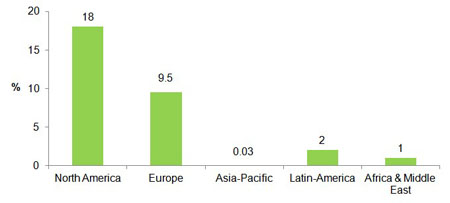
Figure 2: Percentage of the population with health and fitness clubs memberships by region
Running, biking and swimming are the primary forms of fitness around the world, reflecting that the most popular activities are still old-school, quite simple, and can be done outside without requiring a gym facility. Fitbit, a fitness tracker company, analysed the data of more than one million users from 2010 to 2014, including data from different regions, including the US, Asia and Europe.4
Looking at the results of the total data, classical workouts — such as running, biking, swimming, rowing, and strength training — are most popular, followed by aerobics, elliptical workouts and yoga. Besides the top workouts, women generally like to take classes such as pilates or aerobics. They like to exercise together with friends, so sport also has a social aspect for them. Men are more driven by the concept of reaching a goal and the option to participate in a competition. They like football/soccer and also consider, surprisingly, gardening to be a sport (Figure 3).
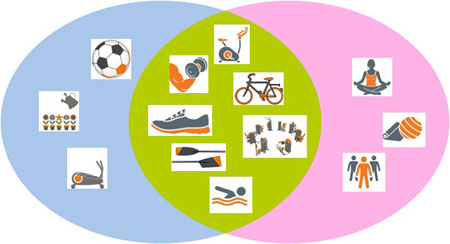
Figure 3: Popular sports activities by gender: pink = activities preferred by women; blue = activities preferred by men; gender neutral activities
The Europe Active Report from Deloitte reported in 2014 about the European health and fitness market. The study indicated that the main motivation for physical activity is to improve health and fitness, followed by the wish to relax and have fun (Figure 4). Weight management and the desire to improve mobility are also reasons to exercise. Nevertheless, more than 50% of the population do not exercise, mainly because of a lack of time and motivation. Being overweight is seen to be an impediment to doing sports, which is unfortunate, as physical activity supports a healthy weight.5
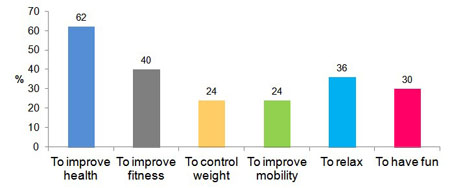
Figure 4: Motivating factors to participate in sport (Europe)
The intensity and frequency of physical activity may also depend on age. High activity at a young age is followed by a time period of fewer workouts, possibly because people focus on their career and familiy. The motivation to do sport often returns when people reeach the 'midlife crisis' age. Many people aged 46–55 are fitter than they ever were, often particpating in competitive events for the first time. From the age of 60, the level of physical activity decreases.6
The ideal thing would be to maintain the motivation of youth for sport and to profit from the benefical effects of sports during ageing. Innovative concepts that combine physical activity, a balanced diet and condition-specific supplementation may improve physical and mental performance at any age and consequently increase the desire to remain active.
Sports and health
Regular exercise at an activity level that complies with an individual’s physical constitution is healthy, helps to maintain physical and mental fitness, and helps to prevent age-related diseases. Physical activity has beneficial effects on cardiovascular health, lung capacity, immune defence, muscle mass, bone and joint strenght, brain function, metabolism and digestion. Even after the first few steps, blood circulation and oxygen supply, as well as the body’s metabolism (particularly fat oxidation) are stimulated. Consequently, nutrient uptake is improved and muscle biogenesis plus mitochondrial activity start to provide the necessary energy. In addition, the improved circulation enhances cognitive performance, such as concentration and memory. Furthermore, sport promotes inner balance, positive mood and good sleep (Figure 5).
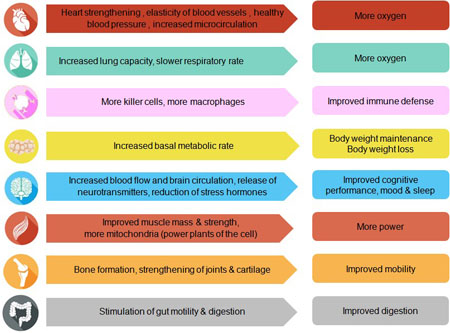
Figure 5: Beneficial effects of sports
Exercise stimulates physical adjustments so that the body is better prepared to cope with the next training session. It is known that training and repeated exercise leads to increased physical performance. As newcomers struggle with being out of breath, suffer from muscle fatigue and sometimes develop 'shaky legs,' it is important to take a stepwise approach to increasing physical activity to make sure that motivation doesn’t become frustation becaase of sore muscles. Health ingredients can support this physical adjustment, facilitating the journey into the world of sport.
Athletes and their goals
Based on motivation and goals, sportspeople can be divided into four types: endurance athletes, bodybuilders, lifestyle athletes and body-conscious athletes (Figure 6).

Figure 6: Endurance athletes, a bodybuilder, lifestyle athletes and body-conscious athletes
Endurance athletes and bodybuilders normally follow a structured training programme and consume a health-conscious diet to reach personal goals. It might be to improve their endurance, be able to participate in a race or improve muscle mass and strength to take part in a bodybuilding competition. For both groups, mental focus and concentration are important, both before and during the contests. Lifestyle athletes want to stay fit and healthy at any age. They exercise regularly, although the activities may vary, and participating is more important than winning.
Body-conscious athletes are mainly females who want to stay in shape or reduce their body weight. As well as weight management, body composition and shape are also important; their aim is to reduce their body fat and support lean muscle development with physical activity and a healthy diet. A high percentage of this group in the US and Europe has a health/fitness club membership and regularly buys sports nutrition products or food supplements.
Sport and nutrition
The main objectives of sports nutrition are improved physical performance during training and competition, and faster post-workout recovery. All athletes have similar basic physical requirements and nutritional needs.They all need energy for physical power and they need to relax and concentrate on what they’re doing. In addition, they need to remain hydrated and be able to support muscle regeneration.
Endurance and body-conscious athletes differentiate themselves from bodybuilders in one aspect. Bodybuilders want to increase muscle mass, which requires the stimulation of protein biosynthesis. Endurance and body-conscious athletes need to convert as much fat as possible into energy to reach their goals. Unfortunately, this process is regulated by enzymes that can’t work in parallel. Fat oxidation requires the activation of the metabolic enzyme AMPK (AMP-activated protein kinase) and muscle development depends on the activity of the enzyme mTOR (mechanistic target of rapamycin).
As protein biosynthesis needs energy, the AMPK blocks mTOR. When sufficient energy is available, mTOR is reactivated and anabolic processes can begin (Figure 7). it is important, therefore, to separate endurance and strength training, and to support the regulation of the relevant enzymes with nutrition.
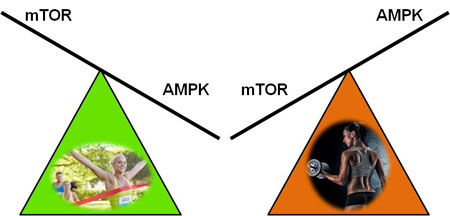
Figure 7: AMPK and mTOR activation as they relate to endurance and bodybuilding activities
Nutrition products have a positive image. They are healthy per se and even convince consumers who do not exercise to buy sports nutrition products because they want to balance out their lack of physical activity with a healthy diet. At first, this sounds absurd; but, new scientific findings show that this approach could make sense.
Several independent scientific studies have demonstrated that beneficial metabolic key master switch enzymes, such as AMPK and Sirtuin 1 (SIRT1), are both responsible for energy homeostasis. The activation of these enzymes improves sugar and fat metabolism and circulation. Based on this, nutrient supply and uptake is more efficient, and more muscle cells and mitochondria are generated. The process is comparable with physical activity and the associated bodily adjustments. Health ingredients, which activate SIRT1 and AMPK, are able to boost the beneficial health effects of sports. This is an important advantage for elderly persons or disabled people who may have a limited ability to participate in sport.7,8
Health ingredients for sports nutrition applications
Sports ingredients can play a supporting role in exercise programmes and contribute to the physical constitution that enables consumers of any age to remain active and reach their sporting goals. Vital Solutions offers innovative, condition-specific ingredients that meet consumer demands to maintain their health and fitness. Its health ingredients are controlled from field to fork; they are neither limited by taste nor technology and can be used in modern food supplements or food and beverage formulations. Part II of this article will introduce the ingredients, their benefits and the possible applications in sports nutrition concepts.
References
1. WHO: Global Recommendations on Physical Activity for Health (www.who.int/dietphysicalactivity/factsheet_recommendations/en).
2. Nielsen Survey: Les Mills Global Consumer Fitness Survey (2013): http://w3.lesmills.com/in-your-club/west-coast/en/news/fitness-is-the-world’s-biggest-sport/.
3. Statista: Memberships of Health Clubs Worldwide by Region (2009–2014): www.statista.com/statistics/273068/total-number-of-health-clubs-worldwide-by-region/.
4. Fitbit Activity Index (2014): www.fitbit.com/uk/activity-index.
5. Deloitte: Europe Active Study (2014): http://www.europeactive.eu/blog/europeactive-and-deloitte-publish-new-official-european-health-fitness-market-report.
6. Activity study of a Germany health insurance company.
7. A. Gerstgrasser, et al., 'In Vitro Activation of eNOS by Mangifera indica (Careless) and Determination of an Effective Dosage in a Randomized, Double Blind Human Pilot Study on Microcirculation,' Planta Med. 82(4), 298–304 (2015).
8. R.W. Hunter, et al., 'Mechanism of Action of Compound-13: an alpha1-Selective Small Molecule Activator of AMPK,' Chem. Biol. 21(7), 866–879 (2014).
